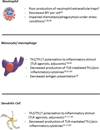Role of innate immunity in neonatal infection
- PMID: 23297181
- PMCID: PMC3959733
- DOI: 10.1055/s-0032-1333412
Role of innate immunity in neonatal infection
Abstract
Newborns are at increased risk of infection due to genetic, epigenetic, and environmental factors. Herein we examine the roles of the neonatal innate immune system in host defense against bacterial and viral infections. Full-term newborns express a distinct innate immune system biased toward T(H)2-/T(H)17-polarizing and anti-inflammatory cytokine production with relative impairment in T(H)1-polarizing cytokine production that leaves them particularly vulnerable to infection with intracellular pathogens. In addition to these distinct features, preterm newborns also have fragile skin, impaired T(H)17-polarizing cytokine production, and deficient expression of complement and of antimicrobial proteins and peptides (APPs) that likely contribute to susceptibility to pyogenic bacteria. Ongoing research is identifying APPs, including bacterial/permeability-increasing protein and lactoferrin, as well as pattern recognition receptor agonists that may serve to enhance protective newborn and infant immune responses as stand-alone immune response modifiers or vaccine adjuvants.
Thieme Medical Publishers 333 Seventh Avenue, New York, NY 10001, USA.
Figures
References
-
- Lawn JE, Cousens S, Zupan J T. Lancet Neonatal Survival Steering. 4 million neonatal deaths: when? Where? Why? Lancet. 2005;365(9462):891–900. - PubMed
-
- Lukacs SL, Schoendorf KC, Schuchat A. Trends in sepsis-related neonatal mortality in the United States, 1985–1998. Pediatr Infect Dis J. 2004;23(7):599–603. - PubMed
-
- PrabhuDas M, Adkins B, Gans H, et al. Challenges in infant immunity: implications for responses to infection and vaccines. Nat Immunol. 2011;12(3):189–194. - PubMed
Publication types
MeSH terms
Substances
Grants and funding
- GM-40586/GM/NIGMS NIH HHS/United States
- 1R01AI100135-01/AI/NIAID NIH HHS/United States
- T32 GM008721/GM/NIGMS NIH HHS/United States
- GM-81923/GM/NIGMS NIH HHS/United States
- R01 GM081923/GM/NIGMS NIH HHS/United States
- R01 GM097531/GM/NIGMS NIH HHS/United States
- R01 AI100135/AI/NIAID NIH HHS/United States
- R37 GM040586/GM/NIGMS NIH HHS/United States
- F32 GM093665/GM/NIGMS NIH HHS/United States
- T32 GM-08721/GM/NIGMS NIH HHS/United States
- R01 GM040586/GM/NIGMS NIH HHS/United States
- F32 GM-093665/GM/NIGMS NIH HHS/United States
LinkOut - more resources
Full Text Sources
Other Literature Sources
Medical


